China, Cuba Significantly Enhance Bilateral Trade & Investment Ties
Bilateral trade up 18% as countries expand trade, R&D and ties with Asia in numerous sectors
China’s President Xi Jinping hosted Cuba’s President Miguel Díaz-Canel at the Great Hall of the People in Beijing late last month, with China’s foreign ministry announcing that Xi and Díaz-Canel “witnessed the signing of bilateral documents on party-to-party exchange, the consultation mechanism between the two foreign ministries, Belt and Road cooperation and practical cooperation.”
China is among Cuba’s major trade partners and is actively involved in its development. On the other hand, Cuba is an active member of the Belt and Road Initiative. The two countries share close cooperation in infrastructure, technology, science, tourism, and energy.
The Chinese foreign ministry statement highlighted the fact that Cuba’s president “is the first head of state from Latin America and the Caribbean (LAC) to visit China after the 20th CPC National Congress,” which “speaks volumes about the special and friendly relations between the two parties and two countries.” The statement pledged to work with Cuba on the Global Development and Global Security initiatives and stressed that the two nations will “jointly advance the socialist modernization drive.” China, the statement continued, “attaches great importance to the development of its relations with” Latin American and Caribbean countries, including “high-quality Belt and Road cooperation.”
An article in the Global Times, China’s English-language mouthpiece, noted that China–Cuban cooperation will include the construction of a “Digital Silk Road” and a “Health Silk Road.” In particular, the “Health Silk Road” and the creation of the “Digital Silk Road” hold great promise for the two countries. These sectors of their bilateral cooperation span a wide range of industries, including electronics, textiles, energy, agriculture, information, genetic engineering, medicine, and health.
Another Global Times article discussed that Latin America is currently expressing its opposition to perceived America’s antagonism toward the hemisphere’s “left-wing” governments. Cuba and other Latin American countries, the article reports, are “tired of [the United States’] hegemony and coercion.” It should be noted that nearby Venezuela has reached significant energy and investment agreements with Russia.
Cuba’s leader had met with Russian President Vladimir Putin in Moscow prior to his visit with Xi. China and Russia have established what both countries call a “strategic partnership” in opposition to the U.S.-led global order.
China also agreed to restructure Cuba’s debt and to provide trade and investment credits to Cuba’s economy.
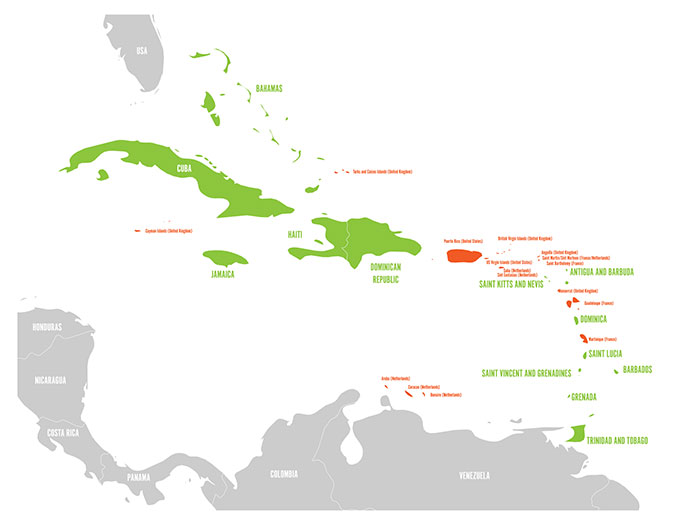
Nowadays, China has grown to become Cuba’s largest trading partner, a key source of funding, and the primary provider of technology for the execution of projects prioritized for the country’s economic and social development. On the other hand, Cuba is beginning to establish itself as a reliable supplier of rum, lobster, sugar, nickel, and tobacco for the Chinese market.
Numerous Chinese companies are working on several projects in Cuba, many of which are related to the development and modernization of the country’s infrastructure, telecommunications, renewable energy sources, the tourism industry, and other key areas.
Since the outbreak of COVID-19 in 2020, China and Cuba have actively carried out anti-epidemic cooperation. After the emergence of COVID-19 in Cuba, China helped Cuba with many batches of medical materials and shared experiences in diagnosis and treatment.
Green and digital transformation are two other important fields of cooperation for China and Cuba, considering both countries’ efforts toward achieving sustainable development. Specifically, energy has long represented the goal of Cuba’s socioeconomic development strategy. By 2030, the country plans to have 24 percent of its electricity supply come from renewable sources. Within the same period, China proposed to achieve carbon neutrality.
In 2021, Cuba officially joined the “Belt and Road Energy Partnership” (BREP), which promotes cooperation in the energy sector that benefits both parties, aids nations in solving problems associated with energy development, achieve common development and prosperity, and makes positive contributions to the creation of a world community with a “shared future for mankind.” Since then, the two countries have signed several construction and energy deals, with the goal of generating momentum for continued cooperation between China and Latin America by utilizing the complementary strengths of both parties.
China-Cuba bilateral trade
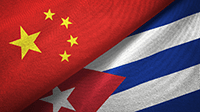
In recent years, the bilateral trade between China and Cuba has maintained good momentum. At present, China is Cuba’s largest trading partner, and Cuba is China’s second-largest trading partner in the Caribbean region. In 2021, the trade volume between China and Cuba reached US$1.02 billion, a year-on-year increase of 7.2% of which China’s exports to Cuba reached US$576 million, a year-on-year increase of 19.2%. In Q1-Q3 2022, hina’s import volume from Cuba grew by 18.1%.
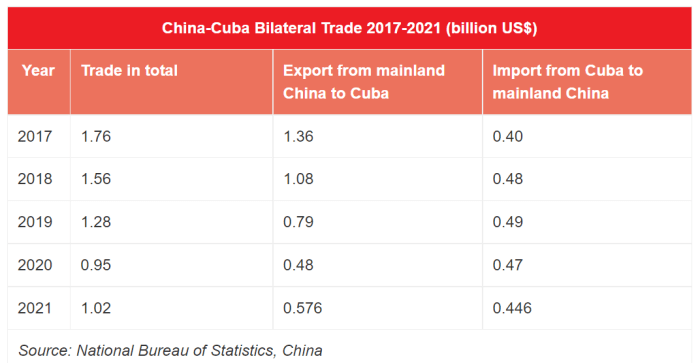
In 2021, the top exports from Cuba to China included ores, slag, and ash (US$153.1 million), nickels and articles thereof (US$151.8 million), sugars and sugar confectionery (US$89.1 million), fish, crustaceans, and molluscs (US$39.1 million), tobacco and manufactured tobacco substitutes (US$5.2 million).
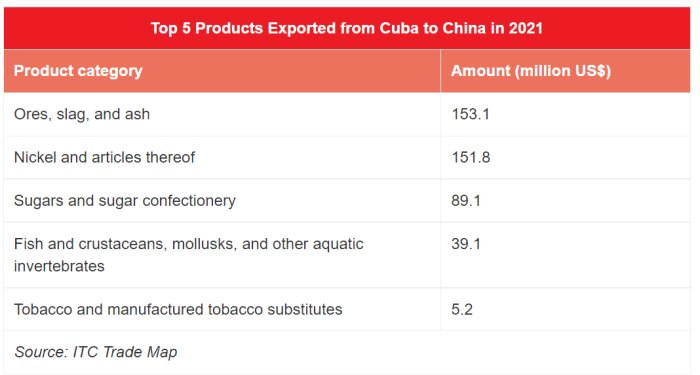
In 2021, the top exports of China to Cuba included electrical machinery and equipment, sound recorders and reproducers, television image and reproducers, and other components (US$133.3 million), machinery, mechanical appliances, and nuclear reactors (US$103.6 million), vehicles and accessories (US$48.7 million), pharmaceutical products (US$28.8 million), and iron and steel (US$24.6 million).
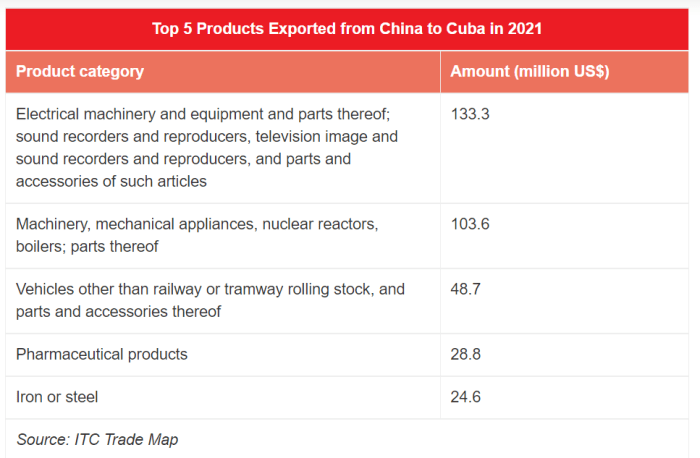
China-Cuba bilateral investment and cooperation
According to data from China’s Ministry of Commerce (MOFCOM), Chinese investment flows into Cuba reached US$11.4 million in 2020, while total Chinese direct investment stock reached US$140 million.
That same year, Chinese-invested enterprises signed 37 new underwriting projects in Cuba with a total new signed contract value of US$314 million and a completed turnover of US$142 million. At the end of 2020, there were a total of 383 Chinese laborers working in Cuba.
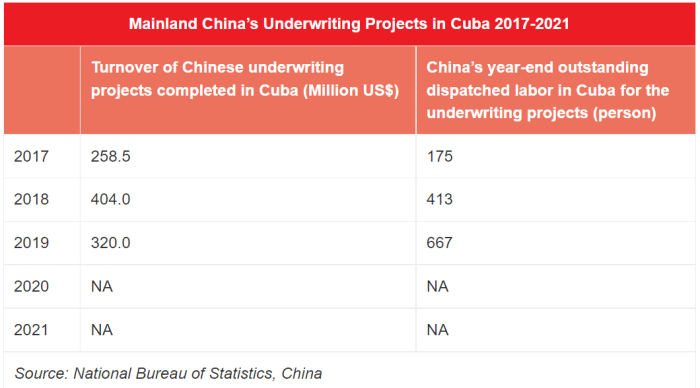
In January 2015, the state-backed China Communications Construction Company Limited (CCCC) won the contract to modernize the port of Santiago de Cuba, which is the main maritime facility on the eastern side of the island, and the country’s second-largest port after Mariel near Havana. This was the first Cuban infrastructure project underwritten by a Chinese Company. Chinese government aided this multi-purpose wharf project, with a total contract value of US$ 120 million. The construction was completed in June 2019.
Energy and natural resources
Due to its relatively small size and limited natural resources, Cuba is reliant on imports to meet its energy needs. As such, it actively collaborated with other countries to help meet its energy needs, both through international trade and through expanding energy projects at home.
China and Cuba have collaborated on energy projects for many years. As mentioned earlier, Cuba officially joined the BREP in 2021.
Chinese companies have been invested in Cuba’s energy industry for many years. Great Wall Drilling, a subsidiary of China National Petroleum Corp (CNPC), has been active in the country since 2005 and is a key contractor for the drilling of Cuba’s oil wells.
To secure its energy security, Cuba is now also seeking to increase the share of renewable energy in its share of energy consumption, setting a target of 24 percent by 2030. China and Chinese companies will likely have a large role to play in Cuba’s energy transition, with several renewable projects already underway.
In 2019, construction began on the Mariel Solar project, a joint venture photovoltaic energy project between Shanghai Electric’s subsidiary SE Energy Investment and UK-based Hive Energy. The 62MW solar park, which is based in the Mariel Special Development Zone (ZED Mariel), was reportedly successfully connected to the grid for power generation in 2021.
Despite its relatively limited natural resources, Cuba does have stores of minerals such as nickel and chrome, which are in high demand in China. As such, China’s mineral and mining companies, such as China Minmetals Corp, have long had a presence in the island nation.
Biotechnology and pharmaceuticals
Over the past two decades, the bilateral cooperation between China and Cuba in the areas of biotechnology and pharmaceuticals has seen steady development with impressive results.
On November 22, 2004, the two countries signed an MoU to acknowledge the advancement of their cooperation in this sector. This MoU was renewed in 2009 and expanded during President Xi Jinping’s visit to Cuba in July 2014.
In 2019, the NDRC of China and the Council of State of Cuba jointly organized the 10th Joint Working Group on Biotechnology meeting in Havana. Working sessions were held in the fields of industry and biotechnology, science and technology, regulatory affairs, agriculture, and health. On that occasion, the MoU between BioCubaFarma (Cuba’s organization in charge of coordinating national efforts in the biomedical sector) and NDRC was extended for another five years. Of the 100 research and development projects that the company was working on at the time, 20 of them were allocated to Chinese counterparts.
As a result of this cooperation, three joint ventures —Biotech Pharmaceutical Co., Ltd in Beijing, Changchun Heber Biological Technology Co., Ltd in Jilin province, and Shandong Lukang Heber Co., Ltd in Shandong province— made particular contributions in the fields of human health and agriculture.
BioCubaFarma has thus far registered four products in China:
Nimotuzumab, a humanized monoclonal antibody from Biotech Pharmaceutical for the treatment of nasopharyngeal cancer and other tumors, which has helped more than 50,000 Chinese patients and is now pursuing approval for two additional tumor indications (head and neck and esophagus).
Human recombinant interferon alpha 2b for the treatment of Hepatitis B and C, from Changchun Heber Biological Technology Co., Ltd.
Ateromixol (PPG) for hypercholesterolemia, from Hubei China- Cuba Biopharmaceutical Co., Ltd.
Aikexian, a biofertilizer from JV Shandong Lukang Heber Biotechnology Co., Ltd.
In the New East Lake High-tech Zone in Wuhan, there is also a Cuba-China industrial complex for the production of PPG and other natural goods. Similar to this, Cuba announced the joint development of the first joint biotechnology park with China, to be built in Fangchenggang, in China’s Guangxi province, led by the joint efforts of BioCubaFarma and Guangxi Fukang. The park is expected to become an experimental industrial hub in drug research and procurement for China and the ASEAN region.
Science and technology
In sectors of mutual interest, Cuba and China have long-standing cooperative interactions. The two countries established a Joint Commission for Scientific and Technical Cooperation to evaluate and coordinate the compliance with cooperation programs as a result of the Agreement of the Scientific and Technical Cooperation between the Governments of the Republic of Cuba and the People’s Republic of China, signed in Beijing as early as 1989.
The most recent Joint Committee was held in 2019. Both parties had the chance to look back on accomplishments in the areas of brain research, biomedicine, and other cooperative endeavors. The meeting’s final minutes listed the key areas for future cooperation to foster and conduct in-depth discussions on issues, such as cooperation between scientific parks, personnel exchanges, and support for collaborative research.
A good example of this collaboration is the Brain Mapping Project, jointly carried out by Cuba, China, and Canada, which has been extended for another three years as a result of its ground-breaking findings.
Another noteworthy accomplishment is the Joint Cuba-China Laboratory for Frontier Research in Translational Neuroethology at the University of Science and Electronic Technology of China (UESTC) in Chengdu, which conducts research on the early detection, intervention, and rehabilitation of numerous neurodegenerative diseases and mental disorders.
Tourism
Another area of cooperation between Cuba and China is tourism. This is a natural partnership. Tourism accounts for around 10 percent of GDP, reaching a total of US$12.16 billion in 2019, prior to the pandemic. Meanwhile – prior to the pandemic – China was one of the world’s major sources of international tourists, with a total of 155 million outbound tourists in 2019.
China’s Trip.com Group, a leading Chinese online travel agency, also signed an MoU with the Cuban Ministry of Tourism in 2019, and in 2021 received the Cuban Consul General in Shanghai to explore opportunities to promote Cuba as a tourist destination to Chinese consumers.
As it currently stands, China’s COVID-19 curbs and quarantine requirements for inbound travelers will continue to stymie outbound tourism to any part of the world, including Cuba. However, once China does decide to lift restrictions – and it has been gradually doing so in recent months – we expect to see a wave of Chinese tourists who are eager to travel the world again. Given the close ties between the two countries and Cuba’s legacy as a tourist destination for Chinese travelers, the country will be ready to receive them.
China-Cuba investment and trade agreements
China and Cuba have signed two bilateral treaties to facilitate investment and business exchange between the two countries. These are a bilateral investment treaty (BIT) and a double taxation avoidance (DTA) treaty.
Bilateral investment treaty
The China-Cuba BIT, signed in 1995, guarantees protection to investors and their investments of both contracting countries in the other contracting country. This is codified in the most-favored-nation (MFN) clause, which also ensures that investors from the other contracting country receive the same treatment as that extended to investors from each party’s own country and investors from a third country.
Investors covered by the BIT include:
- Citizens of the PRC and Cuba; and
- Companies legally established within the territories of the PRC and Cuba.
Meanwhile, investments covered by the BIT include:
- Movable and immovable property and other property rights such as mortgages and pledges;
- Shares, stocks, and other types of participation in companies;
- Claims to money or to any other performance with economic value;
- Copyrights, industrial property, know-how, and technological processes; and
- Concession conferred by law including concessions for exploration and exploitation of natural resources.
The BIT also guarantees investors from both countries the right to transfer profits derived in the other contracting party’s territory back to their home country. This includes the transfer of profits, dividends, interests, and other income, money from partial liquidation of investment, payables pursuant to loan agreements related to investments, and royalties.
The BIT includes articles on dispute mechanisms, including litigation in a neutral international tribunal.
In addition to guaranteeing the protection of investments, the BIT also requires both countries to take measures to encourage and facilitate bilateral investment, which includes ensuring there are facilities for citizens of the other party to obtain a visa to travel to and engage in business in the other party’s country.
Double taxation avoidance agreement
In 2001, China and Cuba signed a DTA to prevent investors operating in the other party’s country from having to pay tax on profits and income twice.
The DTA covers the following taxes in China:
- Individual income tax (IIT)
- Income tax of foreign enterprises and foreign-invested enterprises
Meanwhile, the Cuban taxes covered by the treaty are:
- Profit tax
- IIT
- Foreign companies with a permanent establishment in Cuba are taxed at a rate of 35% while those without a permanent establishment are taxed at 4%. Cuba imposes a progressive IIT rate of 15% to 50%
- To understand China’s tax regime, see our country portal here.
Under the DTA, business profits are only taxed in the country in which the company has a “permanent establishment”, except in cases where the company has a permanent establishment and conducts business in the other country as well. In this case, only the profits that are attributable to each country’s permanent establishment are taxed by the relevant country.
A company has a “permanent establishment” if it has any of the following in one of the contracting countries:
- A place of management
- A branch
- An office
- A factory
- A workshop
- A mine, an oil or gas well, a quarry, or any other place of extraction of natural resources
It also includes:
A building site, a construction, assembly, or installation project, or supervisory activities in connection therewith, but only where such site, project, or activities continue for a period of more than twelve months.
The furnishing of services, including consultancy services, by an enterprise of a Contracting State through employees or other engaged personnel in the other Contracting State, provided that such activities continue for the same project or a connected project for a period or periods aggregating more than 12 months within any 24-month period.
The DTA also ensures that a company’s profits derived from international shipping or aircraft are taxed only in the company’s home country. That means a Chinese company’s profits from international shipping will not be taxed in Cuba, and vice versa. This also applies to profits from the participation in a pool, a joint business, or an international operating agency.
Multilateral treaties
China and Cuba are both WTO members, which by extension means they are both parties to a range of multilateral agreements on trade and investment. These treaties include:
The Agreement on Trade-Related Aspects of Intellectual Property Rights (TRIPS), requires WTO members to extend intellectual property (IP) rights to the IP owners in any member state or region. It includes a most-favored-nation (MFN) clause, guaranteeing equal treatment for IP rights protection for all member countries and regions, and offers dispute resolution and compensation mechanisms.
Agreement on Trade-Related Investment Measures (TRIMs), which prohibits members from implementing investment measures that have the effect of restricting trade with other members, such as local content requirements (requirements for a company to use locally-produced goods or local services in order to operate in the market).
General Agreement on Trade in Services (GATS), which guarantees MFN status to service providers of any WTO member (except governmental services such as social security schemes, public health, education, and services related to air transport).
Conclusion and future prospects
China and Cuba have deep routes that can be traced many decades back to the two countries’ shared history and ideology as communist countries. Over the past few decades, as China has risen as a global economic power, the relationship has continued to deepen, with many new areas of cooperation being explored and developed.
The two countries also have a synergistic relationship in various fields. For instance, Cuba’s world-leading healthcare industry can be of considerable help to China as it seeks to improve its capabilities and support a rapidly aging population. Meanwhile, China’s considerable expertise and resources in infrastructure development can boost Cuba’s economic development and improve opportunities for Cuba’s citizens.
With the high-level visit of the Cuban President to China, new momentum will be injected into China-Cuba bilateral relations, and more cooperation is expected between the two countries.
Related Reading





